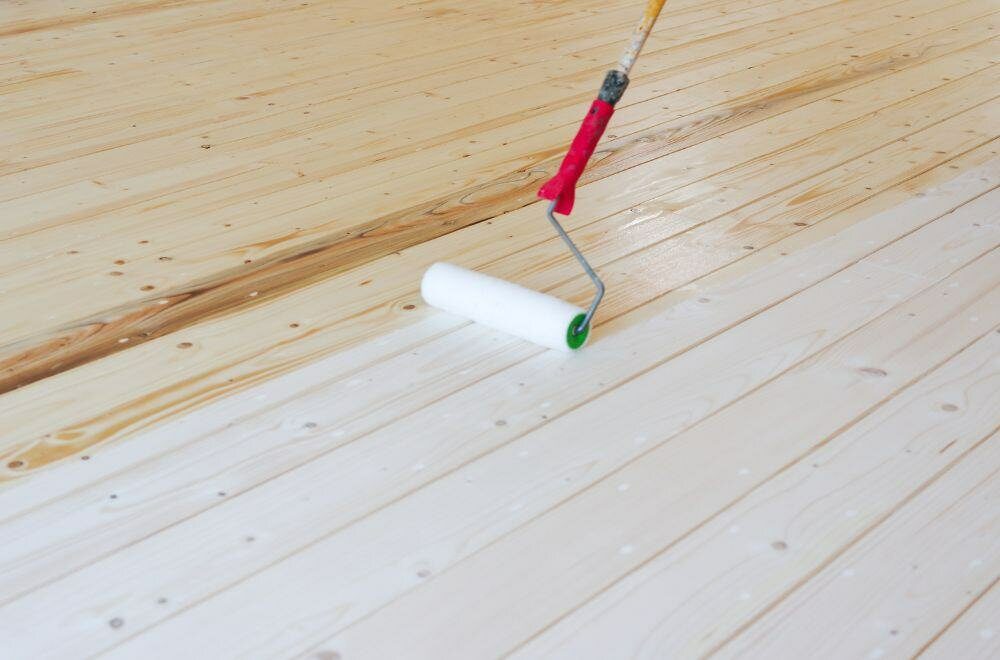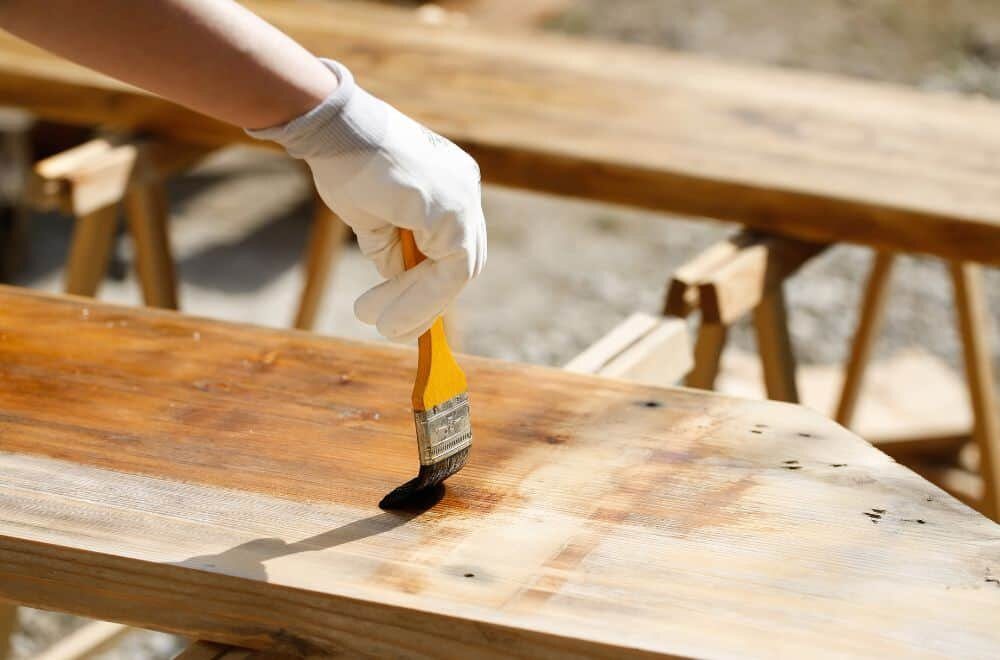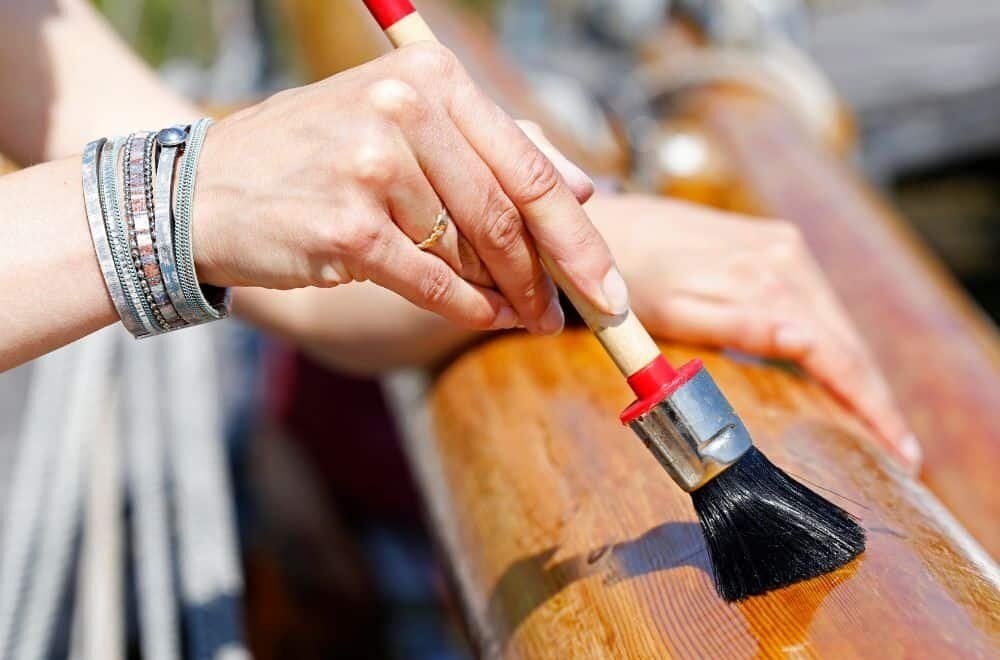Are you wondering if polyurethane makes wood waterproof? This is a common question among those who are looking to protect their wooden surfaces from water damage. While polyurethane is known for its ability to protect wood from scratches and discoloration, it’s important to understand that it does not make wood completely waterproof.
Polyurethane is a synthetic resin that forms a hard, protective film on the surface of wood. This film is resistant to scratches and discoloration from fungi and mildew, and it also makes it more difficult for water to penetrate the wood. However, polyurethane only makes wood water-resistant, not waterproof. This means that while it can repel water and prevent water absorption, it will never fully block it.
Understanding Polyurethane
If you are a woodworker or DIY enthusiast, you must have heard about polyurethane. Polyurethane is a synthetic resin that is used to protect and enhance the beauty of wood. It is a popular choice for finishing woodwork, as it provides a durable, long-lasting finish.
Polyurethane is available in two forms: oil-based and water-based. Oil-based polyurethane is more durable and provides a richer finish, while water-based polyurethane dries faster and has a lower odor.
Polyurethane is a clear, protective coating that is applied to the surface of wood. It forms a hard, durable film that protects the wood from scratches, stains, and moisture. Polyurethane also enhances the natural beauty of wood by adding depth and richness to its color.
Polyurethane is available in different sheens: gloss, semi-gloss, and satin. Gloss provides a high shine, while semi-gloss and satin provide a more subtle shine. The sheen you choose depends on your personal preference and the type of wood you are working with.
When applying polyurethane, it is important to follow the manufacturer’s instructions carefully. Polyurethane should be applied in thin, even coats, and each coat should be allowed to dry completely before applying the next coat. Sanding between coats is also recommended to ensure a smooth, even finish.
In summary, polyurethane is a clear, protective coating that is used to protect and enhance the beauty of wood. It is available in different forms, sheens, and can be applied to different types of wood. When applying polyurethane, it is important to follow the manufacturer’s instructions carefully to ensure a durable, long-lasting finish.
Polyurethane and Wood Interaction

Polyurethane is a popular choice for finishing wood because of its durability and protection against scratches and discoloration. However, it is important to note that polyurethane does not make wood completely waterproof.
When polyurethane is applied to wood, it creates a protective layer that repels water and prevents water absorption. This layer can help to make the wood water-resistant, but it cannot make the wood completely waterproof.
It is important to note that polyurethane may interact differently with different types of wood. Some woods may absorb the polyurethane differently, which can affect the level of water resistance provided by the finish.
Additionally, the thickness of the polyurethane layer can also affect its water resistance. A thicker layer of polyurethane may provide more protection against water damage than a thinner layer.
Overall, while polyurethane can provide some level of water resistance to wood, it is important to use additional waterproofing methods if you need to protect the wood from prolonged exposure to water.
How Does Polyurethane Make Wood Waterproof?
Polyurethane is a popular finish for wood because it provides excellent protection against scratches, discoloration, and water damage. While it doesn’t make wood completely waterproof, it does make it water-resistant. But how does it work?
Polyurethane is a type of plastic that forms a protective layer over the wood. This layer repels water and prevents it from being absorbed by the wood. When water comes into contact with the polyurethane, it beads up and rolls off the surface, rather than soaking into the wood fibers.
The polyurethane layer also helps to seal the wood, preventing moisture from getting in and causing damage. This is important because when wood absorbs water, it can swell, warp, and even rot over time. By keeping moisture out, polyurethane helps to preserve the integrity of the wood.
To get the best water resistance from polyurethane, it’s important to apply several coats. Each coat builds up the protective layer, making it thicker and more effective. You should also make sure to sand the wood between coats to ensure a smooth surface and good adhesion.
Overall, polyurethane is an excellent choice for protecting wood from water damage. While it’s not 100% waterproof, it does provide a high level of water resistance that can help to extend the life of your wood projects.
Types of Polyurethane for Wood Waterproofing

When it comes to wood waterproofing, polyurethane is a popular option due to its water-resistant properties. However, not all polyurethane products are created equal. Here are two types of polyurethane that you can use for wood waterproofing:
Oil-Based Polyurethane
Oil-based polyurethane is a popular choice for wood waterproofing due to its durability and resistance to wear and tear. This type of polyurethane is made from a combination of synthetic resin and oil, which makes it more resistant to water than other types of polyurethane.
One of the benefits of oil-based polyurethane is that it provides a glossy finish that can enhance the natural beauty of the wood. However, it can also yellow over time, which may not be desirable for some wood types. Additionally, oil-based polyurethane has a strong odor and requires proper ventilation during application.
Water-Based Polyurethane
Water-based polyurethane is another option for wood waterproofing. This type of polyurethane is made from a combination of synthetic resin and water, which makes it less harmful to the environment than oil-based polyurethane. It also dries faster and has a lower odor, making it easier to work with.
Although water-based polyurethane is less durable than oil-based polyurethane, it still provides a good level of water resistance. It also dries clear, which makes it a good option for wood types that you don’t want to yellow over time.
In summary, both oil-based and water-based polyurethane can be used for wood waterproofing. Oil-based polyurethane is more durable and provides a glossy finish, while water-based polyurethane is less harmful to the environment and dries faster. Which one you choose will depend on your personal preference and the type of wood you are working with.
Application Process of Polyurethane on Wood

When it comes to applying polyurethane on wood, there are a few steps that you need to follow to ensure a smooth and even finish. In this section, we will guide you through the preparation, application, and drying and curing process of polyurethane on wood.
Preparation
Before applying polyurethane on wood, it is important to prepare the surface properly. Here are the steps you need to follow:
- Sand the surface: Use a fine-grit sandpaper to sand the wood surface. This will help to remove any roughness or imperfections on the surface.
- Clean the surface: Use a tack cloth or a lint-free cloth to clean the surface. Make sure there is no dust or debris left on the surface.
- Apply a wood conditioner: If you are working with a porous wood like pine, it is recommended to apply a wood conditioner before applying polyurethane. This will help to seal the pores and ensure an even finish.
Application
Once you have prepared the surface, it’s time to apply the polyurethane. Here are the steps you need to follow:
- Stir the polyurethane: Use a stir stick to stir the polyurethane thoroughly. Do not shake the can as it can introduce air bubbles.
- Apply the polyurethane: Use a brush or a foam applicator to apply the polyurethane on the surface. Apply a thin and even coat, working in the direction of the grain. Do not overwork the polyurethane as it can cause bubbles and streaks.
- Sand between coats: Once the first coat is dry, sand the surface lightly with a fine-grit sandpaper. This will help to remove any imperfections and ensure a smooth finish. Apply a second coat of polyurethane and repeat the sanding process.
Drying and Curing
After applying the final coat of polyurethane, it’s time to let it dry and cure. Here are the steps you need to follow:
- Let it dry: Polyurethane takes several hours to dry. Make sure to let it dry completely before applying any additional coats.
- Let it cure: Polyurethane takes several days to cure completely. Make sure to let it cure before using the surface.
- Avoid using the surface: Avoid using the surface for at least 24 hours after applying the final coat of polyurethane. This will ensure that the polyurethane has cured properly.
By following these steps, you can ensure a smooth and even finish when applying polyurethane on wood.
Benefits of Using Polyurethane on Wood

Polyurethane is a popular coating for wood surfaces due to its numerous benefits. Here are some benefits of using polyurethane on wood:
1. Protection against damage
Polyurethane forms a protective layer on wood, helping to protect it against moisture, sunlight, and other environmental elements. It also protects wood from scratches and discoloration, making it an excellent choice for high-traffic areas.
2. Enhances the natural beauty of wood
Polyurethane enhances the natural beauty of wood by adding a clear, glossy finish. It gives wood richness and depth while preserving its natural grain and texture.
3. Easy to apply
Polyurethane is easy to apply and dries quickly, making it a popular choice for DIY projects. It can be applied with a brush, roller, or spray gun, and it is available in both water-based and oil-based formulas.
4. Long-lasting
Polyurethane is one of the toughest clear coatings available, making it a long-lasting solution for protecting wood surfaces. It can withstand heavy use and exposure to the elements, making it an ideal choice for outdoor furniture and decks.
In summary, polyurethane is an excellent choice for protecting and enhancing the natural beauty of wood surfaces. Its durability, ease of application, and ability to protect against damage make it a popular choice for both DIY and professional projects.
Potential Drawbacks of Polyurethane on Wood
While polyurethane is a popular choice for finishing wood due to its waterproofing properties, there are some potential drawbacks to consider before using it on your project.
1. Yellowing
One of the most common complaints about polyurethane is that it can yellow over time, especially when exposed to sunlight. This can be particularly noticeable on lighter woods, such as pine or maple. While there are some polyurethane formulas that claim to be non-yellowing, it’s important to keep in mind that all polyurethane is susceptible to this issue to some degree.
2. Difficulty of Application
Polyurethane can be difficult to apply evenly, especially for novice woodworkers. It can also be prone to drips and runs, which can be frustrating to deal with. Additionally, because polyurethane dries quickly, it can be challenging to correct any mistakes once they’ve been made.
3. Potentially Harmful Chemicals
Some polyurethane formulas contain volatile organic compounds (VOCs), which can be harmful to your health if inhaled. If you’re working with polyurethane in a poorly ventilated area, it’s important to take precautions such as wearing a respirator mask and opening windows to increase air flow.
4. Not Suitable for Outdoor Use
While polyurethane is waterproof, it may not be suitable for use on outdoor projects. Exposure to sunlight and other weather conditions can cause the finish to break down over time, which can lead to cracking, peeling, and other issues. If you’re planning to use polyurethane on an outdoor project, it’s important to choose a formula that’s specifically designed for outdoor use.
Overall, polyurethane can be a great choice for finishing wood, but it’s important to be aware of its potential drawbacks before you start your project. By considering these factors and taking the necessary precautions, you can ensure that your finished product looks great and lasts for years to come.
Frequently Asked Questions
How can I make wood waterproof for outdoor use?
If you want to make wood waterproof for outdoor use, you have several options. One of the most effective ways to waterproof wood is by using a sealant or a waterproofing product. You can choose from a wide range of options, including oil-based and water-based products.
What is the best waterproof finish for wood?
The best waterproof finish for wood will depend on the specific project and the type of wood you are using. Some of the most popular waterproof finishes for wood include polyurethane, varnish, and epoxy. Each of these finishes has its own unique properties and benefits, so it’s important to choose the right one for your project.
Is oil-based polyurethane a good waterproofing option for wood?
Yes, oil-based polyurethane is a good waterproofing option for wood. It creates a protective barrier that repels water and prevents it from penetrating the wood. However, it’s important to note that oil-based polyurethane can yellow over time, so it may not be the best choice for lighter-colored woods.
Can polyurethane be used to create a waterproof seal on wood?
Yes, polyurethane can be used to create a waterproof seal on wood. When applied correctly, polyurethane creates a protective barrier that prevents water from penetrating the wood. However, it’s important to note that polyurethane is not completely waterproof and may not provide complete protection in all situations.
What are some naturally waterproof types of wood?
Some types of wood are naturally waterproof and do not require additional waterproofing treatments. These include teak, cedar, and redwood. These woods have natural oils and resins that repel water and prevent rot and decay.
What is the best way to permanently waterproof wood?
The best way to permanently waterproof wood is by using a combination of sealant and waterproofing products. This will create a protective barrier that repels water and prevents it from penetrating the wood. It’s also important to choose a type of wood that is naturally resistant to water and rot, such as teak or cedar.